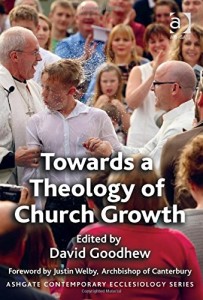 David Goodhew (Ed). Towards a Theology of Church Growth. Farnham: Ashgate, 2015
David Goodhew (Ed). Towards a Theology of Church Growth. Farnham: Ashgate, 2015
This is an important book. It’s the first time such a diverse group of scholars and church leaders from across the different traditions of the church have come together to explore church growth in a positive way. That, in itself, makes it worth the read. But it is not without its flaws. The book is the product of a conference and as such is something of a mixed bag.
In Part 1 editor Paul Goodhew offers a comprehensive introduction summarizing each chapter and seeking, not altogether successfully, to weave a common thread through each whilst passionately making the case that church growth is both good and necessary.
In the second chapter David Marshall calls for a confident Christianity comfortable with proclamation, conversion and church growth even from within a diverse interfaith context. He offers a devastating critique of John Hick, arguing persuasively that, with appropriate humility, proclamation and dialogue can effectively complement one another.
Part 2 offers a biblical account of church growth. In one of the stronger chapters Mark Bonnington locates church growth within a broader kingdom theology that expresses itself through the proliferation of local churches.
C Kavin Row explores the ecclesiology of Acts. In a particularly academic chapter that appears to draw on earlier work, he argues that though the church in Acts was fundamentally counter-cultural it was never revolutionary. It was not clear to me why this chapter was included, other than, perhaps, to challenge the complacent and reassure the skeptical that church growth does not have to be triumphalist.
In part 3, three essays explore church growth and doctrine. The first by Alistair McGrath and the second by Martin Warner are the most disappointing. They seem to be a mishmash of previous work and peculiar interests that do little to develop a theology of church growth. Thankfully, this section is rescued by a superb essay by Graham Tomlin examining the pneumatology of the Pentecostal and Charismatic churches that have seen some of the most significant church growth. He develops a pneumatological doctrine of mission that is compelling, elegant and practical.
In Part 4, the focus shifts to church growth throughout history. Ivor Davidson offers a solid essay on the growth of the early church, but one can’t help but feel there is a hidden agenda here as there is with Benedicta Ward’s chapter on the early English church. Though they both offer some fascinating insights into what made Christianity so attractive in these particular historical contexts, both authors seem nervous about overt evangelism and mission, arguing instead that Christians simply lived well and that this in itself was enough.
The final three essays are the strongest and most interesting so the book ends on a high. Miranda Threlfal-Holmes considers church growth in the medieval period. She highlights the more organic understanding of church growth in which church leaders sought to keep the weeds at bay whilst allowing the garden to grow, a helpful corrective to more modern managerial approaches to growth. Ashley Null examines Cranmer’s systematic approach to the re-evangelisation of the nation, an approach which is breathtaking in its scope and determined intentionality, as Cranmer sought to form, not right doctrine, but right desire across the nation, recognizing that liturgy could be effectively contexualised whilst still alluring the soul with the truth of the Gospel. Dominic Erdozain brings us up to date with the growth of the church in the modern period, contending that the church has too readily embraced a narrative of doom and a theology of resignation instead of a more positive, joyful spirituality that engages the affections and is optimistic for the future.
Goodhew ends with a recognition and celebration of what he describes as a “modest missional ecumenism” and suggests some areas for further research. Despite its flaws and frustrations, it remains a pioneer in its field and, I hope, the shape of things to come as the Church of England embraces the growth agenda.
This book review was originally produced for Anvil Journal. The Journal is currently transitioning to a new partnership with CMS. During this phase, book reviews are being published by Fulcrum.
Rod is Vicar of St Peter’s Harrow, a charismatic, family friendly, Anglican church in North West London. He is married to Joanne and has three girls called Emilia, Orla and Anastasia. He is passionate about Jesus, theology and making disciples. He is also a devoted Chelsea football fan, and a lover of coffee, fashion and road or fixed gear bikes.
Blog: rodgreen.tv. Twitter: rodeagreen
